29th July 2025
Reading is still one of the most important skills, not just in language classrooms, but in life. Reading is how students access information, learn new ideas, and connect with the world. And with AI now part of how we teach, work, and live, reading matters more than ever. Students need to be able to read confidently, think critically, and use strategies that help them understand all kinds of texts—from news articles to chatbot responses.
In this post, we’re going to look at how you can use AI to teach reading skills and strategies. But what are reading skills and reading strategies? These are different things that we do when we read, like predicting before we read something, summarising afterward, or guessing an unfamiliar word as we go. You are predicting as you read this now. If the next sentence was about dinosaurs, you’d stop, read again, and try to figure out what’s going on. That’s because you predicted (correctly) that the next sentence would be related to reading or AI, but not dinosaurs.
Skills like predicting are natural to you and me. But to students reading in a new language, they need to be taught. Lots of teachers practice skimming and scanning with their students, so in this post, we’re going to focus on other reading skills that are as useful, but get less attention. We’ll go through these skills in roughly the same order that we use them, starting with prediction.
Prediction
Prediction means guessing what a text will be about before reading, or what might come next while reading. Good readers use prediction to check their understanding as they read. If something in the text doesn’t match what they expect, they pause and think. For lower-level readers, predicting can make texts easier to understand.
You can use AI to help you write simple questions to ask students before reading. These questions get learners to think about the topic and share what they already know, which is a kind of prediction.
Prediction Prompt: Write five questions that I can ask my students to get them to share what they already know about the topic of the following text. If the text is a story, don’t ask them about the story, but about the concepts in the story. The aim of these questions is to activate learners’ schema. Write the questions in simpler language than the text itself: {Insert text here}.
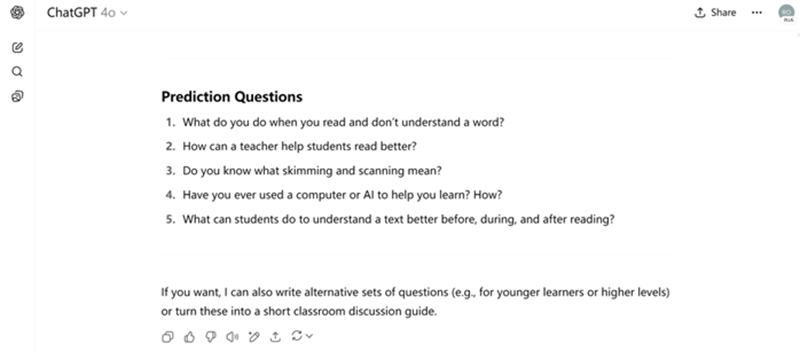
Activity: Word Link
In Word Link, students guess which words will appear in a text. After looking at the pictures from a text (or another prompt, like the title or the first paragraph), students see ten words. Five of these are from the text and five not. They need to predict which ones they’ll read later. This gets students thinking about the topic, activates their prior knowledge, and prepares them to notice important vocabulary while reading.
AI can help you choose words from the text and make up some wrong answers.
Word Link Prompt: Read the text below. Then write a vocabulary prediction task for EFL students. The students will have read the title and first few lines of the story. Text: {Insert text here} ###
1. Choose 5 content words from the text.
2. Choose 5 content words not in the text. Some should be related to the topic, some synonyms for words in the text, some unrelated.
3. Mix the 10 words and write a question asking students to predict which words are in the story and which are not.
4. Scan the text for the 10 words. Confirm how many of the 10 words are in the text. If there are more than 5, rewrite the 10 words.
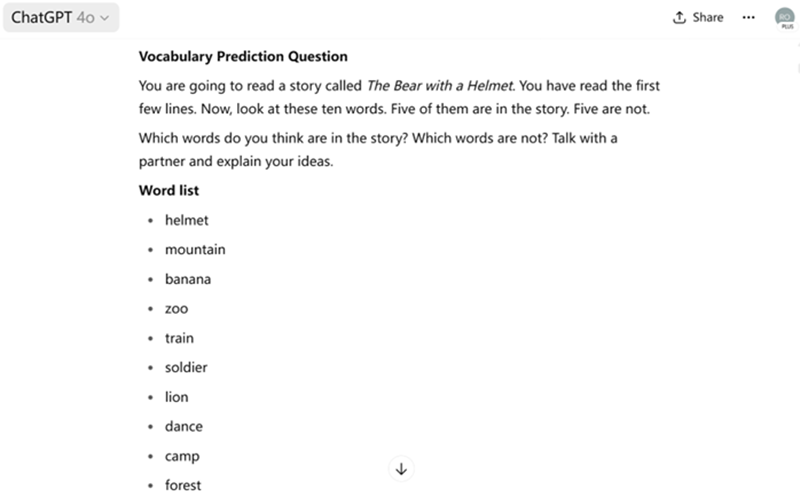
Activity: Guess the Title
In Guess the Title, students try to choose the real title of a story from a short list of options. Start by showing the classes pictures from the story or the first paragraph from the text. Show students some possible titles for the text. They decide which title fits best and why. This helps them think about the topic, make inferences, and talk about their ideas before reading.
AI can help write fake but believable titles for the students to choose from.
Guess the Title Prompt: You are creating a reading prediction activity for EFL students. Use the story text below to create a Guess the Title task.
- Read the story and identify the real title.
- Create 10 fake but believable alternative titles.
- Choose two short sentences or lines from the story that give clues about the topic (but do not mention the title).
- Output the following:
- A list of possible titles (one real, the others fake) in random order
- A follow-up question: “Which title do you think is correct? Why?”
Text: {Insert text here}
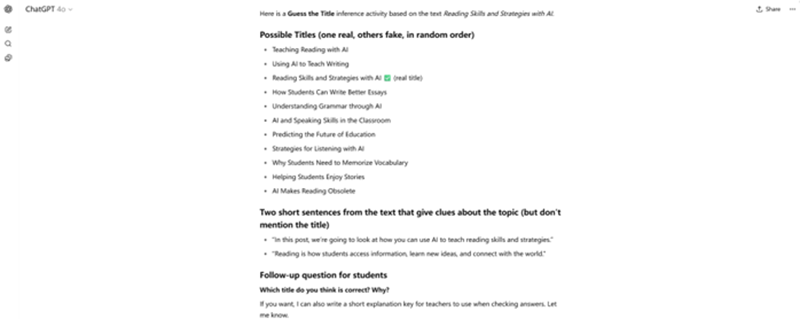
Activity: Unravelling Text
In Unravelling Text students predict as they read. They see one sentence at a time and guess what comes next from a set of options. This helps them focus on how texts flow, using clues like pronouns, time markers, and logical connectors.
Unravelling Text Prompt: You are creating a reading activity for EFL students. Use the text below to complete the following steps:
- Select the first 5 - 7 sentences from the text.
- Present the first sentence as-is.
- For each following sentence, create a multiple-choice question with three options:
- the correct next sentence from the text
- three distractors from later or earlier in the text that do not logically fit after the previous sentence
- Output the following for each step:
- The sentence(s) revealed so far
- The three possible next sentences (labelled A, B, C, in random order)
- The correct answer
- A brief explanation of why it fits (e.g., pronoun reference, time connector, logical link) using simple language.
Text: {Insert text here}

Dealing with Unknown Words
One of the biggest challenges for students learning to read in a second language is what to do when they see an unfamiliar word. For native speakers, sounding it out often helps because the word might be one that they already know from speaking. But for second language learners, this doesn’t work as well. They usually know far fewer words than native speakers. Sounding out a word only helps if you already know the word and can connect the sounds to something you’ve heard before.
Good readers don’t stop or panic when they meet an unfamiliar word. They use strategies - like guessing from context, looking at word parts, or skipping the word if it isn’t important. These are the kinds of habits students need to use and reflect on. Without them, they might get stuck, waste time searching a dictionary, or just stop reading.
Activity: Synonym Search
In Synonym Search students get given a list of familiar words. They need to match these words to less common synonyms in the text, and explain why they think the words match. This helps students learn new vocabulary, and use clues in the text to help them guess.
AI can help you create materials for this by finding difficult words in a text and suggesting simpler synonyms.
Synonym Search Prompt: You are creating a vocabulary task for EFL students. Use the text below to complete the following steps:
- Choose {number} familiar, simpler or more common English words that do not appear in the text in any form (including their comparative, superlative, plural, or tense forms). These words must also not just match the text word with a number, article, or minor modifier added (e.g., teacher ≠ lots of teachers, book ≠ the book, run ≠ runs). Instead, pick words where the text uses a genuinely different synonym or near-synonym.
- Before finalising your list, check that none of your chosen familiar words appear in the story.
- For each word, identify the matching word or phrase from the text and copy the full sentence it appears in.
- Output the following:
- A list of the 4–6 familiar words that students will start with
- A table showing each word’s match from the text and the sentence it appears in
- A sentence frame students can use to explain their choices (e.g., “I think X means the same as Y because…”)
Text: {Insert text here}

Activity: Replace and Check
In this activity, students find unfamiliar words in the text and replace them with simpler ones they already know, checking if the sentence still makes sense. This helps them practice guessing meaning from context. They also see that it’s possible to keep reading without knowing every word. At the same time, they pick up new vocabulary and notice subtle differences between similar terms.
AI can help by finding difficult words and suggesting acceptable answers (which you can use when checking later).
Replace and Check Prompt: You are creating a vocabulary activity for EFL students based on the text below. Follow these steps:
- Choose 4–6 less familiar or challenging words or phrases that appear in the text.
- For each one, write the full sentence from the text where it appears.
- Suggest one or two simpler, familiar replacement words that students might use.
- Check if the replacement makes sense in the sentence. If not, suggest trying a different word.
Output the following:
- A list of the 4–6 target words from the text
- The sentence each word appears in
- One or two possible replacement words
- Whether the replacement works or not
- A sentence frame students can use to explain their choices (e.g., “I think X means Y because the sentence still makes sense.”) Text: {Insert text here}

Making Inferences
Making inferences means figuring out something the writer doesn’t say directly. It’s one of the most important parts of reading, but also one of the hardest to teach. Good readers infer all the time. They read between the lines, connect clues in the text, and use what they already know to fill in the gaps. For example, if a story says “He slammed the door and didn’t look up during dinner,” a good reader can tell that the character is angry. Lower-level readers sometimes focus too much on decoding every word and miss what’s implied. Helping students notice tone, intention, and subtle cues takes practice.
Activity: True, False, or Maybe?
In this activity students decide if statements about a text are true, false, or somewhere in-between. You show them a list of statements. They read the text and decide if each is true, false or maybe. Afterwards, lead a class discussion. This helps them practice noticing the difference between facts and inferences. By justifying their answers with clues from the text, students practice deeper reading comprehension and critical thinking.
AI can help by writing statements for students to look at to decide if they’re true, false or maybe.
True, False, or Maybe? Prompt: You are creating an inference activity for EFL students. Use the text below to complete the following steps:
1. Write 10 statements based on the text.
- At least 2 should be clearly true (the text says this directly).
- At least 2 should be clearly false (the text clearly says the opposite).
- At least 2 should be maybe (the idea is possible, but not directly stated)
2. For each statement, label it True, False, or Maybe.
3. For answers, copy the sentence or short phrase from the text that supports the answer.
4. Output the following:
- The list of statements with their correct labels
- Text evidence for each answer
- A sentence frame students can use to explain their thinking (e.g., “I think it’s True because the text says…”)
Text: {Insert text here}
As an extension, ask students to write their own statements and challenge their classmates to categorise these.
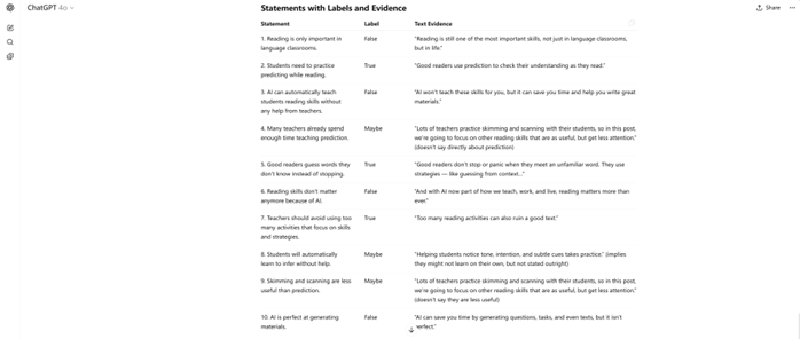
Activity: Jigsaw Story
In this activity, students write a missing part of a story. Each group gets the full text, but with one paragraph or section removed. They read their version, figure out what goes in the gap, and write it. Next, you take away the original parts of the stories. Students are left with the paragraphs that they wrote. They put these together to recreate the story, and check that it makes sense. This activity helps practice inference, structure, and cohesion. It also encourages discussion and collaboration, as students justify their ideas and agree on what makes sense.
AI can help by preparing the different versions of the story and clear instructions for students to follow.
Jigsaw Story Prompt: I am creating a Jigsaw Story activity for EFL students. Use the text below to create materials.
Text: {insert text here}
- Divide the text into 3–6 clear paragraphs of 1–3 sentences each.
- Output the full story first (label it “Full Story (teacher copy)”) with the paragraph numbers.
- Then create a version of the story for each group, with one paragraph missing and replaced by a blank line or “___”. Label each one as Group 1, Group 2, etc., and indicate which paragraph is missing.
- End with a short task description for students, like: “Read your version of the story. Work out what could happen in the missing paragraph. Write 2–3 sentences that fit. Be ready to explain your choice to the class.”
Keep the instructions at a level simpler than the text itself.

Summarising
Summarising means saying the main ideas of a text in your own words. It helps check what students understood, and practices speaking or writing about a text. Summarising is a bit like retelling, but shorter and more focused, covering only the most important ideas. Retelling works well for beginners, while summarising helps students decide what really matters in a text.
Activity: Jigsaw Reading
In Jigsaw Reading, different students read a small part of a longer text. Then, they work with others who read a different part than themselves. The students need to summarise their sections to each other to understand the full story and find answers to questions about the parts they didn’t read. This helps students practice reading for detail, listening carefully, and summarising for their classmates.
AI can help by creating the materials for this.
Jigsaw Reading Prompt: You are creating a Jigsaw Reading task for EFL students. Use the text below to complete the following steps:
- Divide the story into 3-4 logical sections.
- For each section, write 3–5 simple comprehension questions about important details in that part. Use simpler English than the level of the text itself.
- Then, for each section, write a student task that includes only the questions for the other sections (not their own). This way, students must ask classmates for the answers.
Output Format:
- A list of the 3–4 section titles with the matching part of the text for each
- 3–5 questions per section (about that section only)
- A student worksheet for each section, containing only the questions about the other sections (to be used during the jigsaw discussion)
Text: {Insert text here}
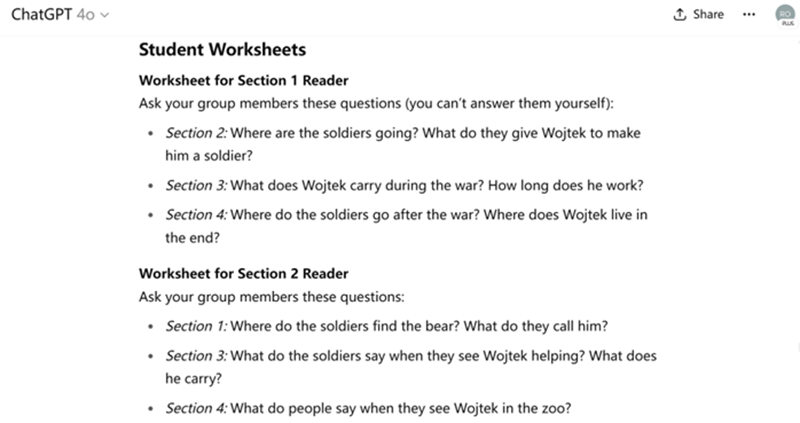
Limitations
AI can save you time by generating questions, tasks, and even texts, but it isn’t perfect. You still need to check what it gives you. Make sure the language level fits your students, the questions make sense, and the answers actually match the text. AI doesn’t know your students, their level, or what they already know. AI might also pick synonyms which aren’t a good match, or might create distractors (wrong answers) which could be correct. To get round these issues, ask for more content than you need. Then pick the best examples to use with your students.
Teaching reading skills also has limits. Skills and strategies won’t do your students much good if they don’t know enough grammar and vocabulary to understand what they read. They’ll also need lots of practice decoding words, especially at lower levels, and opportunities to read fluently. Too many reading activities can also ruin a good text. There’s nothing wrong with letting your students read a good story or interesting text without any skills, strategies or questions getting in the way of the enjoyment of reading.
In this post we only looked at four reading skills and strategies — prediction, dealing with unknown words, making inferences, and summarising. There are many more you can teach (like skimming, scanning, reading fluently, recognising text structure, and reading critically), and many ways to combine them.
Conclusions
There’s much more to reading than just giving students a text and asking questions. Reading is also about helping them predict, infer, summarise, guess words they don’t know, and other things that can help them find their way through difficult texts. These are just four of the many skills and strategies good readers use — and your students need to practice them deliberately.
AI won’t teach these skills for you, but it can save you time and help you write great materials. Use it to generate questions, activities, and prompts that get students thinking about meaning before, during, and after reading.



